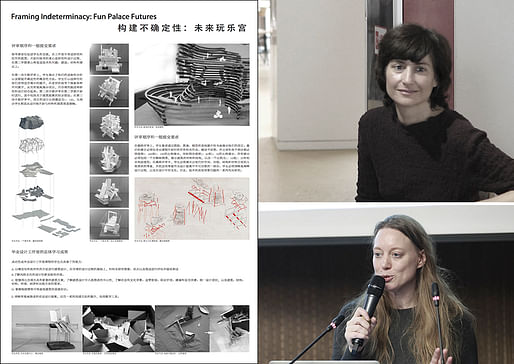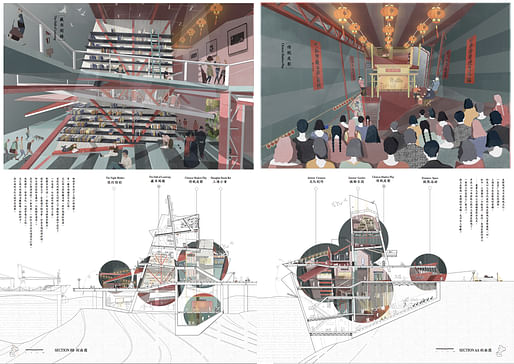
Suzhou, CN
Staff and students from the Department of Architecture at Xi’an Jiaotong-Liverpool University (XJTLU) are celebrating winning three awards in a competition open to all schools and departments of architecture in China.
Submissions from XJTLU won the ‘Outstanding Design Brief’ and two ‘Outstanding Design Studio Coursework’ awards at the 2017 National Architectural Education Annual Symposium in Shenzhen, China. The event was attended by more than 1000 delegates from schools and departments of architecture around China. The prizes were received for a Final Year Project studio brief and two related studio projects.
Only six awards were given in the Final Year Project category in this year’s competition which had received in total 327 submissions of architectural design studio briefs and related resulting students’ work.
The “Outstanding Design Brief” award was received for “Framing Indeterminacy”, a brief collaboratively developed by the teachers Aleksandra Raonic and Claudia Westermann for the Final Year Project studio in year 4 of XJTLU’s BEng Architecture programme. The brief had 13 students enrolled and linked the students to an initiative that had been launched by the Royal British Institute of British Architects (RIBA) in honour of the architect Cedric Price and the artist Joan Littlewood.
30 schools of architecture worldwide participated in the RIBA initiative, whose framework required the tutors of each team to develop their own brief and approach to the Fun Palace Futures general theme. How could the thoughts that guided the development and design of the Fun Palace – a project that was never built but is still today cited as a model for thinking flexible and open architecture –be re-interpreted and re-newed for the future? These were core questions that guided the development of the brief. While all teams had their own focus, and all students worked on their own interpretation and detailed brief, the RIBA framework allowed the students at XJTLU to discuss and exchange ideas as well as questions via online communication media with the teams working at Northumbria University in Newcastle, UK, and at Ion Mincu University of Architecture and Urbanism in Bucharest, Romania. This was valuable, as it allowed the students to gain an understanding of how other students in other parts of the world see and design.
The “Framing Indeterminacy” brief guided the students in an experimental approach to developing a new architecture of participation and exchange for a site located in Shanghai on the west bank of the Huangpu River, around 800m southeast of the historical Bund.
Shanghai, with its history of the foreign settlements and its present that is marked by migrants from all over China, provided a compelling scenery for thinking a new architecture for fun, culture, and exchange as an incubator for participation that reconfigures spaces to places. The students were asked to consider the sequence of events on the stage of this new architecture to reflect the desires and necessities of those taking part, and to take into account that these desires and necessities can only – if at all – partially be directed, predicted, controlled or designed. How open can or should an architectural framework be? How could architecture respond to the unpredictable nature of these processes. What part should it play within the set stage? How can we frame indeterminacy?
The conditions of indeterminacy, of uncertainty, of chance, and change established a challenging framework for the design and creation of a new kind of dynamic architecture. In light of recent developments in architecture that prioritize form as image, the brief suggested to re-consider openness, participation, and performance as fundamental questions of architecture. A lecture covering questions of participation in Chinese traditional art was provided as an entry to re-thinking openness within the Chinese context. In an experimental design process that involved translations of works of art into another medium, the students detected the principles of indeterminacy and developed first ideas for how these principles could become spatial. They developed new tools which allowed them to create a new open architecture. Through this initial experimental research and subsequent design process, the students engaged in thinking multiple view points in relation to narratives of place, and new possibilities for creating interfaces that allow for a form of participation that make users inhabitants.

The two related Final Year Studio projects developed by the 2017 graduates Li Shaokang and Shao Fuwei received the “Outstanding Coursework” award.
Li Shaokang Final Year Project “A Palimpsest of Old Shanghai” captured an understanding of indeterminacy by translating a Chinese shadow play into a series of conceptual models and drawings, and subsequently into architecture. The Chinese shadow play recomposes characters and stories. In a similar manner, story fragments overlap and interlace in the multi-universe of the proposed architecture. It blurs the boundary between time and space and generates new stories. As an homage to Cedric Price - some of the fragments have been developed as mobile units of exchange. They can disconnect and reconnect, and are destined to travel around the world.

The proposal provides a framework for various activities, such as reading, meditating, performing, exercising, and communicating with nature and art. The spaces are mixed and intersected. They contradict prediction. Improbable combinations of activities initiate novelty. Users and inhabitants create their own palimpsests of stories and characters. In the infinite mirror of the proposed architecture, past, present and future become one.
Graduate Shao Fuwei who also received an “Outstanding Coursework” award for his Final Year Project “Shifting Perspectives in the Urban Theatre” states: “Spaces designed by us architects always end up being defined by specific forms, programs and materials. Compositional approaches to the design of architecture with a focus on function, form and material tend to determine the meaning of space. They carry the risk of depriving space of its vitality and to limit the possibilities for future development. While we could attempt to reject control in the process of designing to leave space for users to develop their own spaces, the renunciation of control in the design process is a design decision that risks to lead to an arbitrariness that is essentially defined. We do not seem to be able to escape notions of control. If the rejection of control does not lead to openness, how could we design it? How could we activate and promote social interaction? These were the questions that guided my design research process”.
The proposal takes its initiation from performance art, and suggests a new approach to an architecture of indeterminacy, creating spaces with multiple layers and hierarchies. Frames mark the possibilities for shifts of views, and at the same time they provide a stage for all the activities typically contained in the city. As we are always also on stage and ‘in play’, activities are never fully defined.
The dynamics of these interactions also initiate new activities and new understandings. Users might be reading in a library, or having their hair cut in a barber shop, but they might never know whether not in fact they play Romeo and Juliet, with the book shelves and the hairdresser’s chair figuring as props in a performance. With everyone being an actor, the urban theatre continuously renews itself.
The official WeChat channel of XJTLU's Department of Architecture publishes information in both English and Chinese on the educational programmes and on events. To receive these news, please scan the QR code using your WeChat application.
西交利物浦大学建筑系拥有高度国际化的教学和学术团队,并以国际化视野积极探讨中国以及世界的建筑与城市问题。我们传授创新力、批判性思维、参与能力以及实验精神,鼓励学生探索建筑中的美学和科学。本官方平台发布权威信息,服务校友学生以及家长。
No Comments
Block this user
Are you sure you want to block this user and hide all related comments throughout the site?
Archinect
This is your first comment on Archinect. Your comment will be visible once approved.